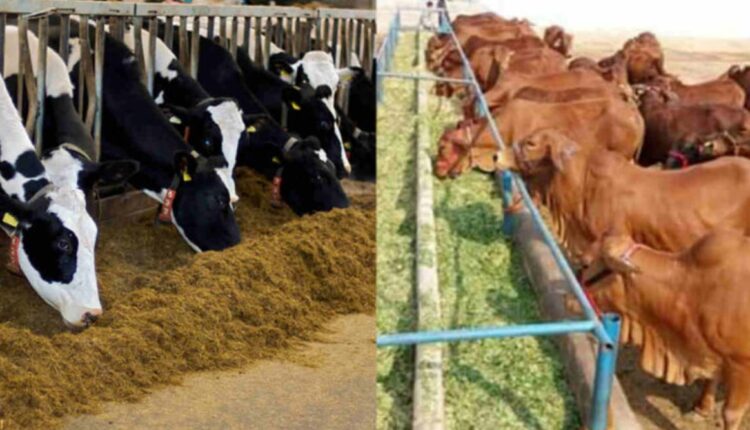Animal Husbandry: Cheap, Accessible and Nutritious Animal Feed
The main diet of animals is straw and green fodder. They should not be fed human food.
It is essential to give nutritious food to animals, but it is not right to give them human food. Some people also want to feed animals all the things that they eat. In animal husbandry, cattle rearers should ensure that animal food matches their taste glands and digestive behavior. On one side, the human body has a simple one-chambered digestive system, whereas ruminant animals like cows and buffalo have a four-chambered digestive system.
Digestive process of ruminant animals
Human food is digested in organs from the liver to the small intestine. But, in ruminant animals, it collects in the first and largest chamber ‘Rumen’ of their stomach. Numerous microorganisms, bacteria, protozoa, and fungi are found in the rumen, which ferments the animal feed. The main diet of animals is straw and green fodder. Straw contains starch. Fatty acids are formed from it during digestion. Ammonia is produced from the protein present in green fodder and from this, ‘microbial’ protein is made by microorganisms.
Urea formation during Digestion
Some of the ammonia produced in the digestive tract of animals is converted into urea through the liver, and either comes out as dung or is recycled by microorganisms to form useful proteins. Protein-free nitrogen that reaches the stomach of animals in the form of a diet also has the same result. In other words, ruminant animals do not consume carbohydrates, proteins, and fats in their original form but convert them into fatty acids. This is how their energy needs are met.
There is no benefit in feeding expensive protein and fatty foods to animals. On the contrary, doing so makes the cost of the dairy business impractical. In fact, animals should be fed only carbohydrates, proteins, and fats from cheap sources as ruminant animals can fully gather their needs from plant food. So, imagine that if you want to produce milk only by feeding cows and buffaloes with the milk itself, then what is the use of such animal husbandry?
No benefit in feeding expensive animal feed
It is essential for farmers to understand that whether they feed honey, milk, protein, or molasses to cows and buffaloes, all these will ferment in their rumen and will produce fatty acids. Feeding them with protein from fodder of leguminous crops, oilseed cake or almond will give ammonia while decomposition (digestion). It will create microbial proteins in the rumen. Similarly, whether you feed them oil, ghee, or any other fatty food, only fatty acids will be formed. Therefore, feeding expensive dry fruits like cashew-almonds or things like grapes-honey to animals does not give any additional benefit.
According to the expert of ICAR-Indian Dairy Research Institute, Karnal, the scientific facts are that the digestive system of ruminant animals is planned in such a way that they are able to manufacture the best quality of protein even after consuming low quality protein. This is the reason why sometimes cattle are fed straw treated with urea so that the microbes present in their rumen can manufacture nitrogen fixing proteins from the urea fraction. It does not mean that only urea treated straw should be fed to the animals but, there are many cheap sources of protein available in the market, which should be used as animal feed.
Animal food myths
Some cattle rearers have a misconception that by feeding desi ghee, milk-almonds and dry fruits to the bull, it will become strong and its fertility will improve. Actually, ruminant animals swallow their food quickly and keep chewing it. Their taste buds are not highly developed like humans. That’s why we should avoid feeding animals the same diet that we eat. Sometimes bread left over in the kitchen or peels of green vegetables can be fed, but it is not sensible to feed expensive food items like milk, honey, almonds, raisins, desi ghee etc. to animals. They may not cause any harm to the animals, but they do not benefit at all.
Use of molasses to increase dosage
Molasses is also added to many animal feeds available in the market for better taste. That’s why animals like it more. Animal husbandry can also feed about 3 kg of molasses mixed with equal quantity of water on fodder daily to high yielding cows. Animals eat it with great fervor. Due to this, their milk production capacity increases. Their diet becomes digestible and they release milk easily while milking. Providing molasses with a low quality diet helps keep animals healthy and protect them from summer stress. That’s why the cattle rearers whose animals eat less diet, they can easily increase the diet of the animals by adding molasses to the diet. The quantity of molasses should not be high as this can be harmful for them.
Animal feed should be Cheap and Balanced
In order to limit the cost of feed, animals should be fed cheap fodder that is able to compensate carbohydrate, protein, fat and mineral elements in their body. Feeding them oil is not only costly but it also affects the micro-organisms found in the rumen. By the way, nowadays ‘bypass fat’ is also easily available in the market. It can be used in the early months of pregnancy, because then the appetite of the animals decreases slightly.
The acidity in the rumen increases by feeding animals with more starchy or soluble sugary substances such as grain etc. This affects the rate of fermentation and digestion, and animals may be at risk of developing disorders such as lameness or acidosis. Many animals eat less straw, so animal husbandry farmers start giving them soluble protein and carbohydrate-rich substances. This can make their digestion abnormal. It is better to feed straw to milch animals as it improves the fat content of their milk. In fact, in addition to carbohydrates, fats, proteins, vitamins, minerals, fiber is very important in animal feed, which is obtained only from straw.
Make animal feed nutritious with ‘molasses’
‘Molasses’ or molasses is a by-product of sugar mills, which is available at a very cheap price. But it cannot be compared to jaggery. Jaggery is also expensive. The quality of the diet can be improved by using molasses at very little cost. Molasses provides 74% dry matter, 6.5% protein, 6.5% sugar and 12.5 megajoules of energy per kg of dry weight. It contains high amounts of sodium, potassium, magnesium, sulphur, while phosphorus is less. Calcium and micro minerals like copper, zinc, manganese and iron elements are also found in abundance in molasses up to one percent.
Points to be kept in mind while feeding animals
Adequate amount of dietary fiber should be taken care of while giving balanced diet to the animals. Cow requires about 18 percent acid detergent and 25 percent neutral detergent fiber in its diet. If the cow’s diet is low, then the energy density should be increased through bypass fat in its diet. So that its energy requirement can be met despite the low amount. Otherwise, her milk supply may decrease. Giving green fodder mixed with straw in milky condition is beneficial. Cattle feed should not contain more than 7 percent fat. Otherwise it can reduce the digestibility of cellulosic feed like straw.
Also Read: Dairy Cattles: How to protect newborn calves from diseases at birth and after birth
Contact us – If farmers want to share any valuable information or experiences related to farming, they can connect with us via phone or whatsapp at 9599273766 or you can write to us at “[email protected]”. Through Kisan of India, we will convey your message to the people, because we believe that if the farmers are advanced then the country is happy.
You can connect with Kisan of India on Facebook, Twitter, and Whatsapp and Subscribe to our YouTube channel.



